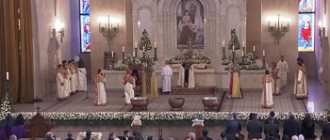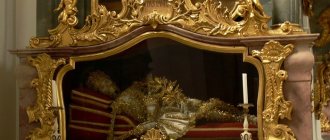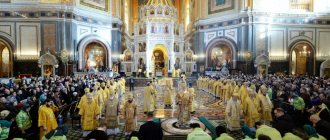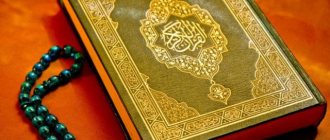The attitude of the Armenian Church to holy icons
In the 10th century, the Byzantines repeatedly accused the Armenian Church of iconoclasm. In this they were supported by the Syrians, Georgians, and Russians. However, architectural monuments and historical and literary publications that have reached us indicate that in the V-VIII centuries. The Armenian Church did not oppose the depiction of the Lord, the Mother of God and the saints, and widely used icons.
In the IX-XII centuries. in different parts of Armenia one could see icons of cult significance, for example, such as: images of the Blessed Virgin Mary, the Varaga monastery (972) and the monastery of the principality of Philaret Varazhnui (1071-1166), the Tarson Cathedral (1197), the Church of Surb Khach Zoravorats in Anavarz (1104). Widespread in those centuries, images of saints were used in frescoes, miniatures and sculpture. To consecrate paintings depicting saints, the Armenian Church performed a special ceremony.
However, along with a reverent attitude towards icons, iconoclastic tendencies arose in the Armenian Church in the 10th century. Two main factors presumably played a role in this. Firstly, in the VIII-IX centuries. Armenia was dominated by the Arabs, who, according to the laws of Islam, had prohibited images of people. In 716, Caliph Yezid 11 ordered the destruction of all paintings in Armenia depicting saints. Thus, icon painting in Armenia was replaced by painting.
Secondly, when Orthodoxy won victory in Byzantium in 843, the veneration of icons became a Byzantine ecclesiastical feature. In this regard, a dogmatic struggle arose between Armenian and Byzantine theologians. Confronting the accusations of the Byzantines, the Armenians (who, quite possibly, had forgotten the veneration of icons under Arab rule) opposed icons because they considered them a feature of the Byzantine Church. This situation prevailed mainly in Shirak, which bordered Byzantium. In areas remote from Byzantium - Syunik and Vaspurakan, icons were still widely used.
By the 11th century, the prevailing iconoclastic situation began to change. Already at the beginning of the 12th century, the Armenian scientist John Sarkavag in his writings formulated the positive attitude of the Armenian Church towards icons: icons help people become closer to the Lord God. Worship of the image of Jesus Christ should be offered to Christ Himself, and not to the substance of the image. Worship of images of the Mother of God and saints should also be directed to Christ. You can only worship before consecrated icons.
Armenia became the first country that, having abandoned pagan gods, adopted Christianity as the state religion. This happened in 301 by the decision of King Tiridates III. According to sacred tradition, the first spreaders of the faith of Christ in Armenia were the apostles of St. Thaddeus and St. Bartholomew, who became the country's first educators. Thus, the Armenian Church established itself from the original source, without the mediation of other churches. This is reflected in its name - the Holy Armenian Apostolic Church (AAC).
In 302, Gregory the Illuminator (Lusavorich) was proclaimed patriarch, who founded the spiritual center of all Armenians, the Etchmiadzin Cathedral, in the capital of Armenia, Vagharshapat. The Enlightener of Armenia began to be called Catholicos (from the Greek - “universal”), Gregory the Illuminator contributed to the spread of Christianity not only in Armenia, but also in neighboring countries and regions. His role was so great that Armenians often called their church Lusavorchakan (Enlightenment).
Christianity in Armenia became the banner of the struggle for freedom, independence and national self-preservation. Therefore, all attempts to impose an alien religion on the Armenians met with fierce resistance from the people. The first armed defense of Christianity in universal history was the famous Battle of Avaray (451), when tens of thousands of soldiers, clergy, old men and women, led by the sparapet (commander-in-chief) Vardan Mamikonyan, opposed the 200,000-strong Persian army. The conscious death of many defenders of the faith forced the Persians to abandon their intention to impose Zoroastrianism on the Armenians.
As later in other countries, Christianity in Armenia acquired national features, which greatly contributed to the preservation of national identity within the same faith of Eastern Rome (Byzantium), which from the 5th century. The western part of Armenia entered after Byzantium and Persia divided the country between themselves. The national specificity of the Armenian Church, supported by dogmatic definitions that are insignificant from today’s heights, but in the medieval period were of fundamental importance, prevented the assimilation of the Armenians with the state-forming Roman (Greek) nation.
In 506, at their own church council in the city of Dvina, the Armenian church hierarchs, declaring their church autocephalous (independent), confirmed their adherence to the formula adopted by the Christian churches before the Council of Chalcedon.
In the “post-Chalcedonian” period, attempts by the Greek Church and the ruling circles of the Byzantine Empire to impose their formulation of the nature of Christ on the Armenians did not stop. This was dictated more by political rather than religious considerations, by the desire of Byzantium to completely integrate the western part of Armenia into the empire and assimilate its people. Such a goal could be realized subject to complete confessional unity. In the Byzantine Empire, belonging to the dominant nation (even the Greeks called themselves Romans - Romeios) was determined not so much by ethnicity as by religious affiliation. Under these conditions, loyalty to one’s Church became a way of self-preservation for the Armenian people.
And, conversely, the Armenians who declared their belonging to the Byzantine Church achieved high social status in the Eastern Roman Empire, but they themselves lost their ethnic identity (that is, they became Greeks). An example of this was many Byzantine emperors and generals who were of Armenian origin, including the Macedonian dynasty. This dynasty included Vasily II, whose sister became the wife of Vladimir the Baptist. This marriage symbolized the adoption of Christianity in Rus' (988) as the state religion.
On the one hand, Vasily II, like many other Armenian emperors, perceived his compatriots as the people of the Byzantine world, but, on the other hand, it was precisely this circumstance that determined the desire at any cost to include them in the state-forming Roman nation. And this was possible only by spreading “Greek Orthodoxy” or Chalcedonism among certain groups of the Armenian population and representatives of its elite. All attempts to subordinate the AAC itself to the Greek Church failed due to historical reasons, because The AAC perceived itself as more valuable in itself, as having been established from the “apostolic source.” The Armenian-Greek confessional disputes are not a religious polemic, but a struggle for the fate of the Armenian population of Byzantium, the second largest ethnic group in the empire.
Thus, the differences that arose were on the political plane. There were no other serious obstacles to the spiritual unity of the AAC with Greek Orthodoxy.
The relationship between the Russian Orthodox Church and the Russian state with the AAC changed at different stages and was often contradictory.
The ambivalent attitude of Byzantium towards the Armenian civilization, in general, and its Church, in particular, was introduced into the “Caesar-papist” Kievan Rus, where there were two centers (vertically - from top to bottom) of decision-making: princely (secular) and church. For the secular authorities, whose attitude towards different peoples determined their geopolitical significance for Rus', the Armenian factor until the 17th century. was irrelevant, since Russia's Caucasian policy was only in the initial stages of formation. In this regard, the image of Armenia and its Church in Russia was created by the leadership of the Russian Orthodox Church (ROC). And this attitude, in turn, was formed under the influence of the Greek Church, for which the AAC was an obstacle in the struggle for the assimilation of the Armenian population of the Roman Empire.
Meanwhile, and after the death of Byzantium (1453), Armenian-Greek church disputes did not cease. The Ottoman government, without ceasing to pursue a policy of forced Islamization and Turkization of the Christian population, could not help but take into account the rejection of this policy on the part of the oppressed population. Trying to take ethnic processes under state control, Sultan Mehmed II issued a code of laws in 1476 (“Kanun-name”), in which he established a special statute for non-Muslim religious communities. All Christian peoples were divided into two communities-nations (“milleti”), Orthodox peoples (Greeks, South Slavs, etc.) were henceforth considered as one community - “rum milleti” (Roman, and in fact Greek, nation). It was led by the Greek Patriarch of Constantinople. The second community, the Armenian one, was also headed by the Armenian patriarch who was also in Constantinople. For the Jews, this role was performed by the Jewish rabbi. The head of the religious community in the Ottoman Empire was the arbiter of justice for his flock and a mediator in relations with the highest imperial administration.
The Turkish government tried, with the help of the Patriarch of Constantinople, to extend its influence to Moscow, the only Orthodox state, and to prevent Russia from joining the European coalition against the Ottoman Empire. That is why, of the two Christian patriarchs, the Greek one enjoyed special favor with the Sultan. However, pursuing the policy of “divide and rule,” the sultans often favored the Armenian patriarch, increasing the jealousy of the Greek patriarch towards the latter, and, as a result, the Greek hierarchs continued to accuse the Armenian Church of heresy.
Thus, until the 17th century. inclusively, Moscow, which assumed the status of the Third Rome, could not help but inherit such a segment of the Byzantine inheritance as a negative view of the Armenian Church.
The attitude towards the AAC changed radically during the imperial period, when, on the one hand, for Russia the Armenian factor became relevant from a geopolitical point of view, and on the other, the Russian Orthodox Church, which had merged with the state, had to determine its attitude towards the AAC from the position of the Caesarist state. And this position becomes positive. Peter the Great was little concerned about insignificant definitions in the interpretation of the nature of the Savior. It was important for him to advance the empire to the South, which he planned to do using the Armenians of the same faith, in whom Peter saw a reliable ally.
The new policy was expressed in the establishment in 1717 in Russia of the diocese of the AAC, the center of which was Astrakhan, where there was a large Armenian colony that arose in the 13th century. In Astrakhan, Moscow and St. Petersburg, the construction of Armenian churches and the registration of parishes began.
After the death of Peter in the South, there was a weakening of foreign policy activity and, as a result, a temporary cooling towards the AAC. Under Elizabeth, the attitude towards it was entrusted to the Synod. The latter again began to use the term “heresy” in relation to the AAC. On January 16, 1742, the Empress issued a decree on the abolition of Armenian churches in Russia.
With the accession of Catherine II to the throne, direct contacts between the Russian government and the Patriarchal Throne in Etchmiadzin are resumed. On June 30, 1768, the Empress signed a Letter sent to Catholicos Simeon Yerevantsi (1763-1780). It confirmed all previous benefits in relation to the Armenians and their Church. In the document we read: “We deign to the aforementioned Patriarch Simeon and the successors of his patriarchal throne, the Armenian people and the law of people found in our Russian Empire for spiritual reasons and church rituals, to have in their department, as it was before.”
In 1768, Catholicos Simeon sent an embassy to St. Petersburg headed by Archimandrite David. The latter presented to the empress from the Armenian Church “the relics of the holy forerunner and baptizer of the Lord, the holy martyr Hripsimiia and the holy great martyr George..., part of Noah’s Ark.” Ultimately, in 1773, the Empress restored the Russian diocese of the Armenian Church, which was headed by the prominent religious and public figure Joseph Argutinsky (1743-1801), who provided the Russian government with significant support in the annexation of Crimea and the Caucasus. In connection with the resettlement of Crimean Armenians to the Don in 1778 and the formation of several settlements, including the city of New Nakhichevan, this city became the largest center of the diocese, after which the diocese of the Armenian Apostolic Church in Russia would later be called.
A new stage in the policy of the Russian government towards the AAC begins during the period of the annexation of the South Caucasus to Russia. As a result of the Russian-Iranian wars in the first third of the 19th century, Eastern Armenia (Karabakh, Yerevan, Nakhichevan) became part of the Russian Empire. As a result of this, the Etchmiadzin Patriarchal Throne found itself within the Russian state. On March 11, 1836, the government of Nicholas I adopted the “Regulations on the management of the affairs of the Armenian Gregorian Church in Russia,” which provided the AAC with limited autonomy. At the time of the adoption of the Regulations, there were six dioceses of the Armenian Apostolic Church in the Russian Empire: Yerevan, Artsakh (Karabakh), Shirvan, Georgian, Bessarabian and New Nakhichevan and Astrakhan. The last two dioceses were created in Russia itself.
The Armenian churches located in St. Petersburg, Moscow, Little Russia, Crimea, New Russia and the Don came under the jurisdiction of the Bessarabian and New Nakhichevan diocese. The North Caucasus, the Volga region, Siberia and Central Asia remained under the jurisdiction of the Astrakhan diocese. Due to the fact that the diocese covered a huge territory, for the operational management of the Armenian churches of the Eastern Ciscaucasia, a division of the Astrakhan diocese was created - the Kizlyar spiritual board, headed by a vicar.
In accordance with Art. 57 of the Regulations approved the structure of the dioceses of the AAC in Russia. They were headed by diocesan commanders, appointed “by the Emperor from among the spiritual dignitaries of this confession.” Diocesan leaders “are determined and dismissed by the Supreme Decrees. When they take office, they take an oath of allegiance to citizenship and service.” In their activities they are “answerable” to the government and “to their spiritual superiors” (v. 58). Within “the limits of their department, diocesan leaders ordain to different degrees of clergy, according to the Order of their Church” (Article 59). The regulations provided for the creation of “Armenian-Gregorian consistories” in each diocese, consisting of an archimandrite and three archpriests (or priests). The diocesan leader presided over them. During the consistory, an office was created (vv. 72-74).
The regulations contained a number of norms that contradicted the canonical structure and traditions of the AAC. The leadership of the Church was made dependent on the government. Thus, all the promises made to the church hierarchs, including Archbishop Nerses V Ashtaraketsi (elected Catholicos in 1843), about the independent status of the church were forgotten. In this regard, Catholicos Nerses V (1843-1857) tried to boldly defend the interests of the Church. On the contrary, Catholicos Matevos I (1858-1865) seemed to come to terms with the diminished status of the Church, which did not exist even in the Ottoman Empire.
The tsarist government showed inconsistency towards the AAC. On the one hand, Russia’s geopolitical interests in the region forced the authorities to agree with the significant role of the Armenian Church in the public life of their people. But, on the other hand, the special status of the Church impeded the government’s desire to assimilate fellow believers. The religious affiliation of the subjects of the Russian Empire actually determined the national one. In addition, the policy of the monarchy was influenced by the nationalization of the Russian Orthodox Church. Some leaders of the Synod, when it was advantageous, suddenly recalled the medieval theological “Greek-Armenian” disputes and tried to use elementary theological differences between the Armenian and Orthodox Churches as a reason for abolishing or limiting the influence of the AAC.
In the early 60s, XIX century. Along with the liberation of peasants from serfdom in the Russian Empire, a relatively liberal era begins in public life. During the same period, the role of the Armenian Church in the development of the spiritual and cultural life of the people increased again, which was greatly facilitated by Patriarch Gevorg Kerestechyan of Constantinople (1813-1882), who was elected Supreme Patriarch Catholicos of All Armenians on September 17, 1866, and received approval from Emperor Alexander II. Having adopted the name of Gevorg IV, the Catholicos begins to carry out deeds, for which he received the nickname Illustrious. He managed to obtain permission from the government to open Armenian schools in areas where Armenians were densely populated, and to confirm the decrees of previous emperors, which allowed the free construction of churches and the opening of parish schools.
The AAC was the main center of national enlightenment, a bastion against natural and deliberately carried out assimilation. Not only progressive-minded people, but also some conservative metropolitan dignitaries were well aware of this role of the Church. The latter sought to “bury” the independence of the Armenian Church using harsh administrative methods. But if over the course of decades this was done gradually, step by step, then at the beginning of the 20th century. such a policy acquired an open and even aggressive character. The tsarist government, at the suggestion of the Minister of Internal Affairs V.K. Plehve and the Caucasian governor G.S. Golitsyn, on June 12, 1903, adopted a discriminatory law “On the concentration of the management of the property of the Armenian-Gregorian Church in Russia under the jurisdiction of the Ministry of National Education, the funds and property of the said Church, which ensured the existence of the Armenian-Gregorian church schools.”
On May 4, 1904, Plehve sent a secret circular to the leadership of provinces and regions in the Caucasus. It said: “The highest order of October 1, 1903 established a rule that, pending the revision of the existing laws on the management of spiritual affairs of Christians of the Armenian-Gregorian confession, the spiritual authorities of this confession, in the appointment of diocesan vicars, members of consistories, rector and teachers of theological academies and seminaries, abbots of monasteries, as well as for the parish positions of rectors, deacons and priests, they asked for consent: for vicars - the head of the Civil Section in the Caucasus, and for the rest - the governor or corresponding official at the place of appointment.”
Specific orders followed. In particular, instructions were given that “in case of detection of unauthorized appointment to such positions or admission to their temporary execution, take measures to prevent persons appointed outside the procedure established by the new law from fulfilling positions, with the removal of the corresponding subscription from them, and in the event of their failure to comply with the requirements local administration on this subject, report their actions to the main Caucasian authorities.”
The “school” problem here acted only as a cover, since the law encroached on most of the property of the entire Church, including all donations that, in the form of capital and real estate, went to church institutions “nationalized” by the government. All classes of Armenian society regarded the law as an act directed against the entire nation, which had always faithfully defended the interests of the Empire in the Caucasus. This was also the opinion of some far-sighted and liberal-minded Russian officials, who sharply opposed the measures proposed by Plehve and Golitsyn.
The authorities, striking a blow at the Armenian Church, counted on the traditional loyalty of the Armenians to the Russian emperor. Therefore, what came as a surprise to her was the widespread movement of all layers of Armenian society in defense of their Church and its (national) property. Despite the fact that the leadership of the Armenian Church at that time was more concerned about the events taking place in Western Armenia, which was part of the Ottoman Empire, where the Turkish government periodically carried out pogroms of the indigenous population, Catholicos Mkrtich I Khrimyan (1821-1907) was the first to raise his weighty voice in defense of the national Church. At that time, there was no end to Armenian youth in the left parties. In Transcaucasia, in order to distract the Armenian people from speaking out in defense of their Church, the Armenian-Tatar massacre was provoked (Caucasian Tatars were then called the current Azerbaijanis).
With these and other ill-considered actions, the government pushed the country toward revolution. The authorities began to realize this very late; on August 1, 1905, Nicholas II signed a decree that actually repealed the law of June 12, 1903. In accordance with this act, the confiscated property was returned to the Church. The news of this was greeted with approval in the Armenian communities of Russia. The Catholicos sent a telegram to the emperor, with which he expressed the gratitude of his entire flock and the wish for “the speedy strengthening of external peace and internal tranquility.”
The Armenian Church has more than once had to overcome the consequences of the “Golitsychtsin”, as well as the “regrettable misunderstandings” that have repeatedly arisen. However, these misunderstandings could not be compared with the bacchanalia that began after the October Revolution of 1917.
After the establishment of Soviet power, the AAC, like other religious organizations in Russia, was subjected to persecution. In the 1920-30s. many priests, and especially representatives of the highest Armenian clergy, were repressed, as a result of which the structure of the Armenian Church on the territory of the RSFSR was almost completely eliminated. Armenian churches were closed and then at various times destroyed in Armavir, Astrakhan, New Nakhichevan, Krasnodar, Stavropol, Holy Cross, Pyatigorsk, Grozny, Kizlyar, Mozdok, etc. The surviving church buildings were turned into warehouses.
The activities of the governing structures of the AAC in Russia were suspended. True, in 1962, at the Church National Council in Etchmiadzin, the Armenian churches were represented by two separate delegations: the diocese of Nor-Nakhichevan and the Moscow parish. The Soviet government, based on foreign policy interests, as well as in order to influence the large foreign Armenian diaspora, was forced to be relatively loyal relate to the AAC, whose leadership was located in Armenia in the city of Etchmiadzin. From 1955 to 1994, the AAC was headed by a major religious figure, Catholicos Vazgen I, despite the church schism, who enjoyed high authority in the diaspora and was well known in the Christian world.
With the beginning of the collapse of the totalitarian system at the turn of the 1980s and 90s, religious life began to revive. In the conditions of democratization of society, the Russian Orthodox Church and the Armenian Orthodox Church, as well as all other church organizations, could determine their lives independently, without pressure from the state. Already the first steps of the leadership of the two Churches testified to the desire to establish truly fraternal relations.
Catholicos Vazgen I, Garegin I (1995-1999) and Garekin II identified as the most important task in their activities the intensification of dialogue with other Christian denominations for the unity of all Christians, especially Eastern Christians, which include both the Armenian and Russian Churches. Back on August 30, 1992, in the “Patriarchal Word to the Armenian People,” Catholicos Vazgen I and Catholicos of the Great House of Cilicia Karekin II emphasized: “History irrefutably testifies that the Christian Churches have always suffered from senseless inter-church strife, rivalry and the policy of proselytism. The page of “Byzantine disputes” in the book of life of the Christian Church has long been turned. The revival of the worst traditions of proselytism, which have sunk into oblivion, the fanning of the flames of “Byzantine disputes” means that history has taught us nothing, and we do nothing to contribute to the unity of the Universal Church of Christ and the common cause of enlightenment (by faith), which is of vital importance for us on the threshold of the 21st century. the fate of Christianity."
The Armenian Church in the past, and especially in the present, considers the most important task to be the education of its flock in love for the Russian Orthodox Church, which is the dearest and closest to it among all sister churches. Regular meetings of the patriarchs of the Armenian and Russian Churches were of paramount importance in their rapprochement.
In January 1993, Catholicos Vazgen I visited Moscow and met with Patriarch Alexy II of Moscow and All Rus', during which a joint statement was signed on the spiritual unity of the two Churches. A further step in strengthening this unity was the official visit of Patriarch Alexy II to Armenia.
On May 1, 1996, a solemn meeting of the two patriarchs took place in the Mother See of Holy Etchmiadzin. Catholicos Karekin I, in particular, Fr.
In his response, the late Patriarch of Moscow and All Rus' Alexy II Fr.
In the Cathedral of St. Etchmiadzin, the Catholicos of All Armenians, on behalf of the Armenian Church, solemnly handed over to Patriarch Alexy II the relics of St. Apostle Andrew the First-Called, which had been preserved in the Armenian Church for centuries. Patriarch Alexy II, receiving the relics of the Holy Apostle, said the following words: “Your Holiness! With a feeling of deep emotion, I accept from your hands, from the hands of the Primate of the Holy Armenian Apostolic Church, a particle of the relics of Chief Apostle Andrew the First-Called. The Apostle, who, according to Tradition, reached the Russian borders and predicted the future of Christianity in Rus'. In recent years, we have regained the relics of many ascetics of faith and deanery... But your transfer of a particle of the relics of St. Apostle Andrew the First-Called is the pinnacle in this chain of acquisition. We will reverently bring them today to our land for the worship of the believing people of our Church. And, praying before these holy relics and receiving prayerful strengthening through the prayers of St. Apostle Andrew the First-Called, we will always remember with gratitude your spiritually invaluable gift. And, turning to the Lord at this touching and sacred moment, we ask that the Lord the Savior would preserve the Holy Armenian Apostolic Church, its Primate, hierarchs, clergy, believers and the entire people of Armenia...” The recently elected Patriarch of Moscow and All Rus' Kirill has repeatedly spoken about strengthening fraternal relations between sister Churches.
The fraternal relations that have developed between the two Churches have had a beneficial effect on the activities of the AAC in Russia. Back in August 1991, the Ministry of Justice of the Russian Federation registered the New Nakhichevan and Russian Diocese of the Armenian Apostolic Church (with its center in Moscow), the divisions of which were vicariates. Thus, in the South of Russia, by the decision of Catholicos Vazgen I, two vicariates were created: Rostov (uniting church communities of the Rostov region and the Volga region) and North Caucasus (communities of the regions and republics of the North Caucasus).
On January 13, 1997, by a special Kontakion (Decree) of Catholicos Garegin I, the Diocese of the South of Russia of the AAC was formed, the head of which was Bishop Yeznik Petrosyan, Doctor of Theology. Since 1999, this diocese has been headed by Bishop Movses Movsesyan. Krasnodar was designated the center of the episcopal throne of the new diocese, to which the Armenian churches of the North Caucasus were subordinate. The Constituent Assembly elected the diocesan council, the highest body of this regional church association.
Thus, in Russia since 1997 there have been two dioceses of the AAC: Nor-Nakhichevan and Russian (Moscow) and the South of Russia (Krasnodar), in their church and community life they are guided by diocesan statutes developed in accordance with the principles of the Charter of the AAC and taking into account the laws about the cults of the Russian Federation.
At the beginning of the new third millennium, the existing good relations between churches close to each other are filled with new content. This is especially felt in the activities of the Armenian dioceses in Russia. Almost all church events held in the Russian Federation took place with the joint participation of Armenian and Russian priests: church consecrations, anniversaries and memorable dates, peacekeeping missions, etc. On the problems of resolving ethnic conflicts, Russian and Armenian clergy have always had a common position.
V.Z. Hakobyan,
Candidate of Historical Sciences, Pyatigorsk
Armenian creeds.
Beginning in the 4th century, the conversion of the Armenians and the establishment of Christianity as the state religion in 301 AD. ushered in a new era of national identity.
Thus, the cross was placed at the center of Armenian icon painting. The results of which left many puzzles in their time until today. When the Crusaders ventured into the highlands of Armenia, they inevitably came into contact with Armenian veneration of the cross.
The Armenian kingdom of Cilicia was a strong ally of the European crusaders and was considered a bastion of Christendom in the East. European crusaders borrowed know-how such as elements of Armenian castle building, art and church architecture.
During the reign of Constantine I, the First Crusade took place. An army of Western European Christians moved through the Armenian Highlands and Cilicia, heading to Jerusalem.
The Armenians in Cilicia gained powerful allies among the Frankish crusaders, whose leader Godfrey de Bouillon adopted the design of the “Jerusalem Cross” from the Armenian iconography of the time.
Armenian assistance to the Crusaders was described by Pope Gregory XIII in his Ecclesia Romana: “Among the good deeds that the Armenian people did for the Church and Christendom, it should especially be emphasized that in those times when Christian princes and soldiers went to the Holy Land, not a single people or nation, did not show the same enthusiasm, joy and faith and did not come to the aid of the Crusaders, as did the Armenians, who provided the Crusaders with horses, provisions and command. The Armenians helped the soldiers with full courage and loyalty inherent in them during the Holy Wars.”
Friendly relations between the Armenians and the Crusaders were linked, and mixed marriages often arose between them. Before becoming king of Jerusalem and founding the first Crusader state to adopt this symbolic cross, Brother Godfrey Baldwin of Boulogne was the first Duke of Edessa (Armenian Urha, Urfa), which he became by adoption as the son of the Armenian prince Thoros of Urha. Baldwin also married the daughter of Prince Thoros, who became the first Queen of Jerusalem.
The kingdom of Armenian Cilicia took place in a principality founded c. 1080 by the Rubenid dynasty, an offshoot of the larger Bagratid family, which at various times occupied the thrones of Armenia and Georgia.
The Armenian royal house of Bagratuni (Georgian Bagrationi) later established themselves as rulers of Iberia (modern Georgia), spreading the use of the Jerusalem Cross in Georgia in the 14th century.
The medieval monk Thomas Kempis, on the issue of the Cross, once remarked: “On the Cross is salvation; in the Cross - life; on the Cross - protection from our enemies; in the Cross - an infusion of heavenly sweetness; in the Cross - strength of spirit; on the Cross - joy of the spirit; in the Cross - the excellence of virtue; in the Cross is the perfection of holiness...” Since 2010, Armenian Khachkars, their symbolism and craftsmanship have been included in the UNESCO list of intangible cultural heritage.











